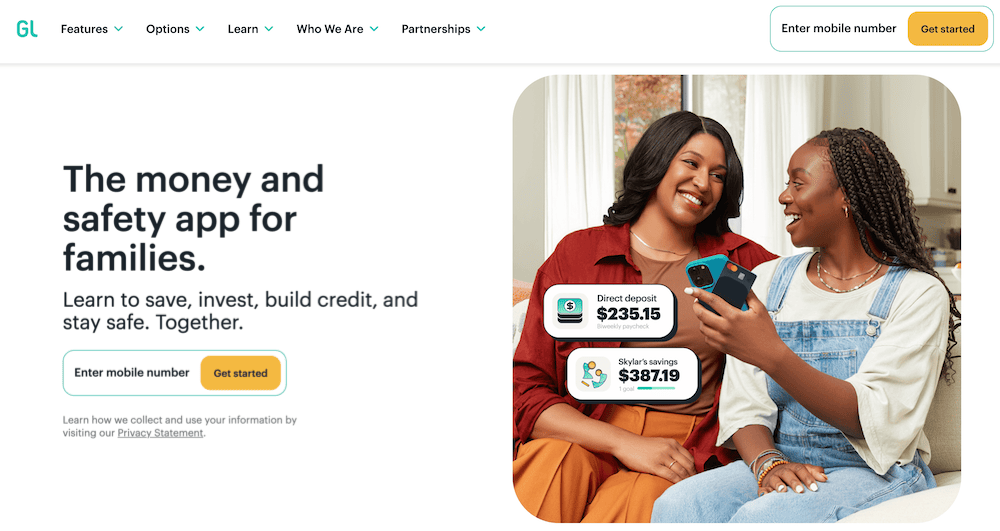Most parents can’t help but feel a little pride when they reach one of life’s great financial milestones: opening up their child’s first bank account. But what exactly do you need to open that account?
Spoiler alert: You can’t just snap your fingers and make it happen.
Minors can’t open a bank by themselves. They need you, and you’ll need a few things to get the ball rolling.
And that’s precisely what we’ll discuss today. We’ll review everything you need to learn how to open a bank account for a minor, what to look for in a child’s bank account, what your kid can use that account for, and other vital details.
Table of Contents
Bank Accounts to Open for a Minor—Top Picks
|
Primary Rating:
4.8
|
Primary Rating:
4.4
|
|
Starts at $5.99/mo. (for up to five kids)
|
Free 30-day trial. Acorns Early: $5/mo. for 1 child. $10/mo. for 2-4 children. Acorns Gold: $12/mo., includes Acorns Early for up to 4 children.
|
What Do I Need to Open a Bank Account for My Child?
A minor might be interested in opening a bank account, but their parents or legal guardians will need to open it for them and list themselves as joint checking account or joint savings account owners. The steps will vary depending on the financial institution.
However, according to general procedures for opening a bank account for children, these steps should generally allow you to open a bank account for your children.
How to Open a Bank Account for a Minor
1. Choose the Type of Account You Want (Checking Account vs. Savings Account)
Banks commonly offer checking and savings accounts for kids these days, and increasingly, they’re combined with banking apps for kids and teens.
Here are some of the most basic types of account you’ll come across:
1. Savings Account
- Best for: newborns and young kids with a long time horizon.
Savings accounts allow you to deposit money and earn a modest amount of interest for money held in the account. These accounts carry Federal Deposit Insurance Corporation (FDIC) coverage worth $250,000 (insurance on your bank account deposits in the event your institution faces financial problems), representing a safe place to store money and earn interest.
2. Checking Account
- Best for: teenagers starting to manage their own money.
A checking account is another bank account that allows you to store money–but it also provides easy access for using your money. These accounts, which also carry FDIC insurance, usually come paired with a debit card and check-writing privileges.
Some accounts have monthly minimum balance requirements and charge service fees. Minors should look for checking accounts with minimal or no fees if possible.
3. Prepaid Debit Card
- Best for: people first learning about managing money.
If we’re being technical, a prepaid debit card is a “stored value” card that works similarly to a gift card. A prepaid card allows you to spend only the money stored on the card, and nothing more—unlike a credit card with a line of credit you borrow against as you spend.
They have their benefits. Prepaid debit cards prevent overdraft fees, thus helping you avoid the costly pitfalls of spending too much or overextending yourself financially. You can’t spend more than you have, and you don’t get penalized for trying.
4. Custodial Account
- Best for: parents who want to open a bank or investment account for a minor.
A custodial account is a savings account an adult manages on behalf of a child under a certain age (usually, 18, 21 or 25, depending on the state). Any financial assets held in the account are owned by the account beneficiary (the minor). These accounts allow adults to make transactions within the account, such as buying and selling investments or saving money for the benefit of the minor.
Custodial accounts allow you to save for future expenses ranging from college or a car to a wedding or even a down payment on a home. Custodians have a fiduciary responsibility for managing the assets held in the account, meaning they are bound ethically and legally to act in the best interests on behalf of the minor.
5. Roth IRA for Kids
- Best for: kids with income looking to grow their money for a long time.
A custodial Roth IRA for kids is a retirement account that allows your child to set aside earned income toward retirement.
Kids can pay lower income taxes now as they contribute to the account–then the money will grow tax-free in the account, and they won’t be taxed when they withdraw their funds in retirement. Those decades of tax-free growth make Roth IRAs a powerful way to leverage compounding returns to a child’s benefit.
There’s an App for That
Restrictions might apply from one banking institution to another. For instance, teenagers generally only have access to kids checking accounts. Regardless of what type of account you pick up, you’ll want one with a feature-rich app.
For instance, with apps such as Greenlight, you can establish parental controls to monitor, manage and shortlist where your kids shop online and offline alike.
Further, you have the ability to assign chores and disburse allowance payments, automate money transfers, offer Parent Paid Interest (this is like the yield that you would earn in a savings account, but instead, it flows from your parental account into your child’s account at rate you determine later), and much more.
Many of these money apps for teens come equipped with useful financial literacy tools for you to teach your kids solid money management.
Do Your Due Diligence
Deciding the account type you want is an important step. Once you settle on this decision, you’ll need to look at which providers make the most sense for your needs.
As with many products geared toward kids, there are myriad kid-focused account providers to choose from. And that can make it challenging to identify which one makes the most sense for your needs.
Banks, credit unions, even fintech companies will offer many of the same account features, but maybe not all of them. So your job is to determine which account features are most important to you and your child.
Among the features to consider:
ATM Networks
You can typically use an ATM card at any cash machine–but if it’s out of your bank’s network, you’re going to pay. A large network means you’re less likely to incur those fees.
Of course, your child might not ever need to withdraw money several states away, in which case, a large ATM network might not matter–just one that has a few machines in your area.
Branch Locations
This is a similar idea to the ATM network, but instead of allowing you to merely withdraw or deposit cash, branches provide a wider array of services.
You might or might not need a high number of branch locations–but you probably want at least one or two conveniently located branches that are easy to visit.
App Functionality
When comparing apps, you’ll want to examine both ease of use (who wants a hassle just trying to check their account balance?) and the app’s tools and functions.
Do you want to be able to limit your child’s spending capabilities, or maybe deposit checks online? Make sure your bank’s app can do all you want it to do.
Interest Rates
We frequently tout the importance of teaching your child about the power of compound interest. Why not give them a practical example that grows their money over time?
Sure, no one will get rich off the interest in their checking or savings account, but more is more–consider looking for a competitive interest rate from your child’s account.
Access to Feature-Rich Debit Cards
All cards are not created equal. Some cards boast features such as parental controls over where their kids shop, or how much they spend. Some also offer purchase notifications and even purchase requests.
Thus, you should make sure the debit card you get has the features that are right for you and your child.
2. Submit an Application
Once you’ve chosen a bank and an account that fits your needs, it’s time to apply–which means you’ll need to submit an application with you as a joint account owner.
The good news is that while some banks and credit unions might make you visit in person to open a kid’s banking account, others will allow you to open a minor’s bank account online. Same thing with several fintech apps.
Either way, the application process should only take about 10-15 minutes. And there are several things you can expect from the process that should be the same no matter what.
First off, you’ll need to provide some sensitive information about yourself. So make sure you have a secure internet connection, and that your financial institution offers a secure web portal.
Be especially careful that you’re not being led to any fake or spoof sites with similar names as your intended bank, credit union or fintech firm.
After verifying you’re in the correct place on a secure connection, you can proceed with the application. The bank will ask a series of questions meant to verify your identity.
This means you’ll need to supply your target bank with some necessary information when you’re opening an account. This includes:
- Your name
- Address
- Date of birth
- Social security number
- Valid government-issued ID
If you’re opening a bank account for your minor online, you’ll provide this information in text box forms found on the website.
If your web browser auto-populates forms with your personal details, make sure they appear in the correct locations on the application. You don’t want your information to appear where your child’s should, or vice versa.
Once you’ve submitted all the requested information, the financial institution will process your application. At this point, your history with other bank accounts is likely to come under review.
Your application will trigger your bank to request information on your banking history by contacting an account verification service such as ChexSystems, a consumer-reporting agency that serves a similar purpose as the major credit reporting bureaus (Experian, TransUnion and Equifax), but for bank accounts.
The agency will create your Consumer Disclosure report–a document containing information about your financial history and any problems you might have had with previous bank accounts.
The agency looks for derogatory marks that might exist on your checking and savings accounts, which you would have picked up from, say, paying late fees, bouncing checks or experiencing fraudulent activity. (The process is similar to when a credit card company processes your application for a credit card and reviews your credit score provided by the credit reporting bureaus.)
ChexSystems assembles the provided information on your Consumer Disclosure report to calculate a risk score–which ranges from 100 to 899, where higher scores are better–based on your consumer banking history. Based on this score, the banking institution will decide whether they will allow you to open an account with them. (Note: Running one of these reports doesn’t ding your credit report with an inquiry.)
If you’d like to access your ChexSystems consumer report, you can get a free copy every 12 months through the ChexSystems site.
If you’re approved for your account, the next step involves funding the account.
3. Fund the Account and Activate the Debit Card
As a condition for opening a joint account with a minor, you often need to fund the account as part of the final stage of the application process.
Placing funds into your child’s account can usually be done with a debit card or credit card, or even a direct transfer from an existing bank account. Some restrictions may apply depending on the institution.
If you opened a checking account, your account might come paired with a free debit card or bank card your kid can use to make purchases or withdraw from their deposit accounts.
Note that while some banks and credit unions offer temporary cards immediately, your actual card could take one to two weeks after application approval to arrive.
When the official debit card arrives, you likely will need to activate it via telephone (by a toll-free number provided on the card) or online through a secure web portal.
However, increasingly, many modern banking apps will allow you to activate the debit card through a smartphone app–and even “carry” it in a digital wallet such as Apple Pay (age 13+) or Google Pay (age 16+).
If your bank, credit union or other financial institution offers a mobile app with your bank account, you should strongly consider downloading it on your phone.
Apps allow you and your child to check the children’s savings account balance and monitor any account fees, transactions and more.
Further, you can use these mobile apps to monitor account activity or restrict access to funds.
Several of today’s most popular apps, including Greenlight and Copper, let parents assign chores and pay allowance through the app with just a few taps.
How Old Do You Have to be to Open a Kids Bank Account?
To open a teen checking account, the parent or accompanying adult must be at least 18 years of age (or the age of majority in the state of residence) and typically the child must be under the age of 18.
But some banks may impose stricter age requirements for kids, requiring them to be under the age of 12 or between certain ages like 13 to 17.
When you open a joint account, both the adult and minor will be on the same account title.
What Do I Need to Open a Bank Account for My Kids?
Now, you can open a banking account with debit card for your child with a few clicks of a button, thanks to digital systems and fintech apps.
As part of the U.S. Patriot Act, the government requires financial institutions to help fight the funding of terrorism and money laundering activities.
Therefore, federal law requires all financial institutions to obtain, verify, and record information that identifies each person who opens an account.
For you, this means you’ll need to supply your target bank with some necessary information when looking to open an account. This includes information like:
- Your name
- Address
- Date of birth
- Social security number
- Valid government-issued ID
To open an account with banks like Wells Fargo, Bank of America, U.S. Bank, or Capital One, a deposit account with a credit union, or even mobile banking apps like Greenlight, you will need to supply a handful of important pieces of documentation.
Afterward, your kid can start making deposits into these joint accounts, working toward financial goals, using a paired ATM card and managing their money.
While what you need may vary by institution, but the information above will be standard requirements. The account holder will need to provide all or some variation of the above items the joint account held between the minor and parent or guardian with the following documents:
- Your driver’s license
- Your Social Security number
- Your child’s Social Security number (potentially a Social Security Card)
- Your child’s birth certificate
- Proof of address (usually a utility bill)
Features to Consider for Opening a Bank Account for Your Kid
Here are several features to look out for when deciding on the perfect bank account for your child.
1. Mobile banking app
There’s no getting around it: Kids are tied to their phones. So it helps to have a financial institution that can provide online banking through a mobile banking app.
Among things to look for:
- An easy-to-use interface
- The ability to transfer funds and set spending limits
- Text and/or email alerts
- Ability for parents to view their own accounts and their child’s account without needing multiple logins.
2. Checking and savings account
Make sure you can segregate your child’s funds in a kids savings account as well as a separate checking account. This can help develop a savings mindset.
One of the best such features in popular banking apps for minors are savings pods that designate money held in the joint account for specific savings goals.
3. Linked prepaid debit card (with parental controls)
Rather than a traditional debit card, a prepaid debit card only allows your child to draw against the balance on the card, preventing overdrafts.
Parents should be able to reload using either cash or electronic bank transfer (EBT), set spending and account limits, request text or email alerts for transactions and deposits, add/remove authorized users on the account from a mobile banking app and receive notifications when their child uses the debit card.
4. Fee menu (monthly, recurring, transactions, ATM withdrawals, card reload, etc.)
Savings accounts for kids make building a nest egg easy and accessible, but that usually comes at a cost. Many accounts typically have a monthly service fee–literally a fee you pay for having the account.
But you might be charged other fees, too, such as ATM withdrawal fees, card reload fees (for a prepaid debit card), annual card fees, overdraft fees and more.
You should always ask a representative about all fees that might be charged–these make a huge difference in how much you’ll end up paying over the life of the account.
5. Interest income
Most kids’ savings accounts earn a small amount of interest. It might not be the same level of passive income offered by high-yield savings accounts (which typically are available only to adults), but it’s typically going to be better than the interest you’ll accrue in a kids checking account.
Also of note: Some apps allow you to be the interest payer through a feature such as Parent Paid Interest.
Compare the Best Online Bank Accounts for Kids
Compare these best online bank accounts for kids that let them save, spend and learn how to manage their money.
1. Greenlight Card

- Available: Sign up here
- Price: Core: $5.99/mo. Max: $9.98/mo. Infinity: $14.98/mo. (All plans include cards for up to 5 children)
The Greenlight debit card allows kids to begin spending, but provides parents with peace of mind by giving them control over where their kids can spend money. Parents also can choose to receive alerts that tell them when, and how much, money is spent on the Greenlight debit card.
Greenlight works like a prepaid debit card, allowing you to transfer money onto the card for your child to pay for expenses at approved locations. You can choose how much money to load onto the card, and your child will be cleared to make approved purchases so long as a money balance backs up the card.
If your child asks for extra money to get added to the card, you can have them take a photo of the purchase they want to make and receive your approval. This gives you control and allows you to have discussions with your child about why a purchase might be a good or bad idea.
And if your child has a job, they can add their own funds to the card as well.
Each monthly Greenlight subscription includes debit cards for up to five kids. Replacement cards cost $3.50 each but are free the first time. If you need to replace your card quickly, you can get express delivery for $24.99. The company also offers a personalized card, with your own photo or design, for $9.98 per year.
Greenlight boasts numerous other features, too. For instance, parents can open an investment account for kids to get their children investing in stocks and ETFs for the first time.
Greenlight also offers monthly savings rewards based on your tier: 2% per annum for Core members, 3% per annum for Max, and 5% per annum for Infinity. You may set up “Parent-Paid Interest” between you and your child. This allows you to foot the bill and pay interest on accounts for up to five kids.
The Greenlight debit card is a good choice for parents looking to teach their kids the importance of saving money and making prudent financial decisions. This financial product can be an effective learning tool for helping kids to understand why saving should be a priority and how to simplify paying an allowance or tracking chores.
Greenlight has no minimum age requirements but recommends starting at age 6 or older.
Read more in our Greenlight Card review.
- Greenlight is a financial solution for kids that allows them to spend with a debit card, earn money on savings, and even invest their money.
- Greenlight offers flexible parental controls for each child and real-time notifications of each transaction. And it's the only debit card that lets you choose the exact stores where kids can spend on the card.
- Parents can use this app to teach kids how to invest with a brokerage account through Greenlight Max and Greenlight Infinity plans.
- Families can earn 2% (Core), 3% (Max) or 5% (Infinity) per annum on their average daily savings balance of up to $5,000 per family. Also, Max and Infinity families can earn 1% cash back on their monthly expenditures.
- Unlike many apps that simply provide features and controls, Greenlight is also designed to spark discussions with children about spending, investing, and more, fostering a better educational experience.
- Best-in-class parental controls (can prohibit specific stores)
- Can add brokerage account to invest in stocks
- Intuitive Parent + Kid apps
- Competitive cash back & interest rates
- Parent-Paid Interest
- High price points
- No cash reload options
- No parent / child lending
Related: Best Greenlight Alternatives
2. Acorns Early / GoHenry (Best for Customer Service)

- Available: Sign up here
- Price: Acorns Early: $5/mo. for 1 child. $10/mo. for 2-4 children. Acorns Gold: $12/mo., includes Acorns Early for up to 4 children.
A longtime player in the kids’ debit card/financial app space has a new name and a new face: GoHenry, which was acquired in 2023 by Acorns, has officially become Acorns Early.
Many reviewers have long painted Acorns Early/GoHenry as just a way to spend. However, I see it as a real financial solution for minors—a debit card, yes, but also an app-based ecosphere that provides education and experience for the child, as well as ways for parents to keep their kids safe and teach them responsibility.
When you open an Acorns Early account, each child receives an Acorns Early Mastercard debit card that can be used anywhere Mastercard is accepted (so, millions of vendors). Not only can kids spend online and in stores, but they can also use their Acorns Early debit card to withdraw cash from ATMs. The standard Acorns Early debit card itself is included in the monthly subscription. However, your child can also choose to stylize their card with one of 35 different designs—most designs require a $5 one-time fee, though certain “limited edition” designs will be $6.
GoHenry really stuck out to us as one of the best prepaid debit cards for kids because of their outstanding customer service. Good news there: Acorns Early users should expect a similarly high level of customer support, including seven-day-a-week phone service from 5 a.m. to 7 p.m. PT, as well as 24/7 live chat support.
Parents have two ways of signing up for Acorns Early:
- Signing up for an Acorns Early account for either one or two to four children.
- Signing up for Acorns Gold. Not only does a subscription come with a free Acorns Early account for up to four children, but you can also open an Acorns Early Invest account—a custodial account that allows you to invest for your kids’ future.
Acorns Early has no minimum age requirements but recommends starting at age 6 or older. Learn more in our Acorns Early review.
A note for current GoHenry users: For now, your app, features, and cards will continue to work as normal. However, if you want all of the latest features, you’ll need to download the Acorns Early app from the iOS App Store or Google Play.
- Acorns Early (formerly GoHenry) is a debit card and financial app designed to provide education, experience, and confidence in saving, spending, and earning, to kids ages 6-18.
- Kids get a Mastercard debit card that allows them to spend in stores and online, and withdraw money from ATMs.
- Kids can also earn allowance, complete chores for money, set savings goals, even give to charity.
- Parents can rest easy knowing there are plenty of guardrails in place, including chip-and-PIN technology, Mastercard Zero-Liability Protection, and parental controls such as spending notifications, card locking, and adjustable spending limits.
- Acorns Early also provides educational resources tailored for kids of all ages.
- GoHenry's reputation for excellent customer service among kids' debit card providers will continue through Acorns Early, which is offering everyday phone availability and 24/7 chat support.
- Subscribing to Acorns Gold includes not only a free Acorns Early account for up to four children, but also Acorns Early Invest, a UGMA/UTMA custodial account where you can save toward your kids' future and get a 1% match on up to $7,000 in contributions annually.
- Special offer: Get a free 30-day trial and $5 allowance when you sign up.
- Strong parental controls (including card-use controls and adjustable spending limits)
- Chores and allowance
- FDIC insurance
- Allows for ACH payments
- Convenient "Giftlinks" for non-accountholders to give money to kids' accounts
- Customizable cards ($5-$6)
- No investing feature
- No fee-free ATM network
Related: Best Investing Apps for Teens Under 18 Years Old
Are Money Apps for Kids Safe?
Money apps for kids boast a number of features that allow your child to save safely:
- These apps require a parent or guardian to open the account if the owner is a minor. (Note: The account will transition to the account owner’s name after they reach the age of majority, which is 18, 21 or even 25 in some states.)
- Banking apps for minors come with cybersecurity controls, multi-factor authentication (think both a password and a text code) and banking integration through Plaid, a leading cybersecurity provider in the financial industry.
- The money kept in these bank accounts carry standard Federal Deposit Insurance Corporation (FDIC) insurance coverage. This type of insurance protects deposits of up to $250,000 in value held in each account, in the event of a bank failure.
These apps offer a safe and secure experience for kids, teens and minors. But, just like any other bank account, children are at risk of scams.
Parents must teach their children about safe money handling processes and how to be mindful of phishing scams or other attempts to steal their money.
Can I Open a Bank Account for My Child Online?
The answer to this question will depend on the bank. Some banks let you open an account online; others will require that you visit your nearest branch to prove your identity.
To open a bank account online for your child, you’ll need to upload photos proving your and your child’s identities.
What Do I Need to Know About Taxes With Kids’ Bank Accounts?
Yes, you may face tax implications for having a bank account or custodial account which pays interest or other investment income. This applies to any unearned income, including interest, dividends or capital gains.
The taxes you face depend on the type of account you set up, but all follow the same Kiddie Tax rules by the IRS with respect to unearned income.
- Savings accounts. If your child makes more than $2,500 in unearned income (interest income in this case) in a given tax year, you and they may need to pay taxes.
- Custodial accounts. If a custodial account makes more than $2,500 in unearned income from interest, dividends or capital gains in a year, the minor and yourself will likely need to pay taxes.
- Trust funds. Minor beneficiaries and other beneficiaries of a trust fund are responsible for paying taxes on any unearned income produced and distributed by the trust. Trusts may be subject to taxation if distribution is made. Tax liability can change depending on the size and nature of the trust as well as applicable tax laws. If you’re considering setting up a trust fund, consider visiting Trust & Will to learn more about your options and how a trust will be taxed.
Gifting Money to a Child’s Account
As of 2024, you can gift up to $18,000 per year ($19,000 in 2025) to a single person without needing to document the financial gift with the IRS.
This means you can learn how to gift stock to a UGMA account without paying any extra taxes. If you have a spouse, they can also gift up to $18,000 per year ($19,000 in 2025).
Opening a Kid’s Bank Account: An Important Financial Stepping Stone
A bank account for your child is a great way to teach them about personal finance and what it takes to develop financial responsibility.
When opening a bank account for your child, you need certain types of documentation to support identities and citizenship and then the process you’d likely face for applying and opening the account.
From there, you need to manage the account held at a bank, credit union or online banks through leading financial apps for kids.
Your job as a joint account holder is to manage money and help them to develop their own money management skills.
Next, you may need to look into credit cards for your kid, which will require credit approval and understanding interest rates (and how not to pay them by paying off your credit card each month).















